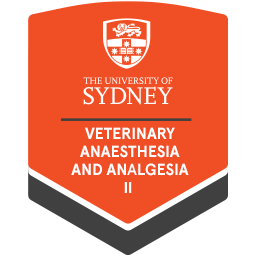Visit 2024 Anaesthesia & Analgesia: Compromised Patients Distance Education course page
In this course, participants will extend their existing skills in the process of decision-making in the planning and administering of anaesthesia and analgesia in patients with a range of clinical problems and presentations with the aim of minimising complications and optimising outcomes.
They will be encouraged to use a problem-based approach to devise individualised protocols for patients presenting for emergency procedures and for those patients with co-morbidities such as impaired renal and cardiac function and diabetes, undergoing elective procedures.
Prerequisite: participants are assumed to have a sound knowledge of anaesthesia foundational principles (including drug physiology and anaesthesia equipment). Please see the 'Who should enrol' section for further details on assumed knowledge.
Learning Outcomes
After completing this course, participants will be able to:
- Identify anaesthetic risk factors and potential complications
- Devise plans to minimize risks and complications
- Formulate first line approaches to managing peri-anaesthetic complications
- Formulate a plan for peri- and postoperative analgesia
in patients with common comorbidities or special presentations (e.g. renal insufficiency/disease, extremes of age, endocrine disease, BOAS, cardiac insufficiency/disease) and emergency presentations (e.g. trauma, C-section, gastric dilation/torsion, urinary obstruction).
Modules
- Anaesthesia for patients with common comorbidities/disorders and special conditions
- Anaesthetic consideration for patients requiring emergency anaesthesia and/or surgery
What is Distance Education?
Premium, intensive online veterinary CE
All CVE Distance Education (DE) programs are mentored by leading veterinary experts who will provide individual feedback and advice on completion of the modules. Each module may include written content, technique videos, self-reflections, quizzes and online submission of assignments.
Maximise the opportunity to expand and consolidate your learning by participating in the tutor moderated group discussion forum.
Who should enrol?
This course is suitable for qualified veterinarians.
Assumed knowledge: It is expected that participants in this course are already competent at the following learning objectives which were covered in Anaesthesia & Analgesia Course 1 - Fundamentals:
- Devise a protocol for preanaesthetic preparation aimed at
minimising risk and optimising safety of anaesthesia
- Inform on inhalation anaesthesia equipment including on use, maintenance, testing, and patient appropriate setting up
- Rationalise the importance of perianesthetic monitoring including
the choice of methods of monitoring based on understanding of respective
advantages, disadvantages and limitations.
- Competently and confidently manage common peri-anaesthetic complications through application of a systematic approach
- Justify the inclusion of premedication as part of an anaesthetic protocol.
- Apply understanding of pharmacology of drugs commonly used for
sedation and or pre-anaesthetic medication
- Describe the significance of drug redistribution and metabolism of
intravenously administered anaesthetics for recovery from anaesthesia.
- Suggest and justify a strategy for parenteral (intravenous)
induction of anaesthesia to minimise adverse cardiopulmonary effects
during induction.
- Discuss the effects of commonly used inhalation anaesthetics on cardiopulmonary and CNS function.
- Differentiate between the effects of the patient related factors and
the physicochemical factors of inhalation anaesthetics on the uptake
of/recovery from inhalation anaesthesia.
- Rationalise the use of analgesics for pre-emptive analgesia, multimodal analgesia, and balanced anaesthesia.
- Integrate analgesia into the anaesthetic protocols for the surgical patient.
Digital Badge
On completion of this course, participants will earn a Veterinary Anaesthesia & Analgesia micro-credential digital badge. Digital badges are verified credentials that allow earners to easily communicate their skills and qualifications online. A digital badge can be used in email signatures, websites and social media platforms and contains verified metadata describing the qualification and the process required to earn it. Please note: this is not a higher education award and not a qualification recognised under the Australian Qualifications Framework. Further information can be found in the micro-credential terms and conditions.

Pay as you learn
Choosing your DE course is a big commitment, so there’s no need to add further stress by paying your course up front. To pay as you learn, you will need a AU$1,000 deposit to secure your place, followed by 50% of the total course fee 10 days prior to course commencement date. We’ll arrange simple monthly direct debits from your credit card over 3 months.
Note: Payment Plan will incur an additional AU$250 administration fee, and Early Bird rates do not apply if you choose the payment plan option.
| Course fees |
Super
Early Bird |
Early Bird |
Full Rate |
| Member* |
$2,385 |
$2,450 |
$2,520 |
| eMember / Non-member |
$2,650 |
$2,650 |
$2,650 |
*Members include: Practice, Professional, Part-time Professional, Recent Graduate, and Academic members.
Loyalty DE Discount: Completed 2 or more (or all 3 Diagnostic Imaging, Dermatology or Anaesthesia & Analgesia) Distance Education (DE) courses in the previous 5 years, you are eligible for a 10% discount on future DE courses. Discounts are not cumulative. For further information about discount please read the full Terms. To redeem your discount contact the CVE via email [email protected] or phone +61 2 9351 7979 (Monday to Friday, AEST 9am to 5pm).